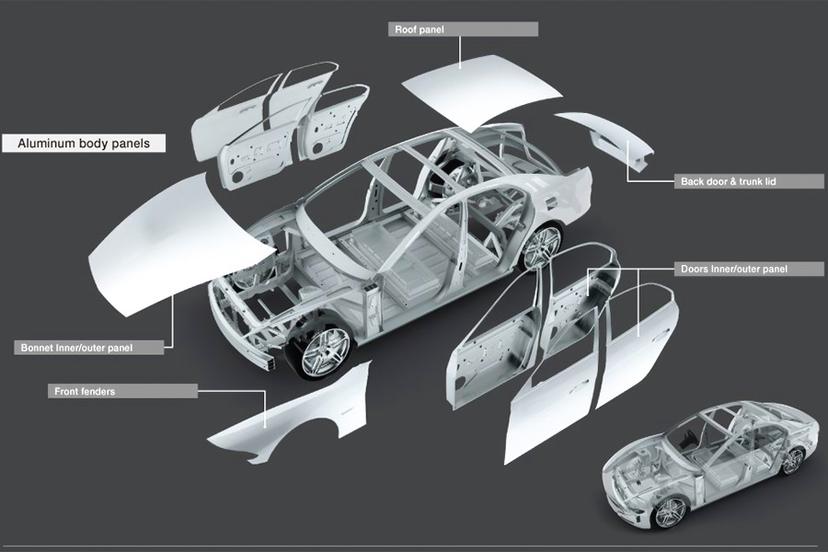Sheet metal fabrication is a technologyfor comprehensive cold deformation fabrication of metal sheets, covering a variety of processes such as shearing, stamping, bending, welding, riveting, and surface treatment. This process plays a vital role in modern manufacturing due to its ability to create complex shapes and structures. This article will explore the specificapplications of sheet metal fabrication in different fields.
What is Sheet Metal Fabrication?
Sheet metal fabrication is the blanking, cold or hot forming of metal sheets, aluminum profiles and pipe fittings without changing their cross-sectional characteristics, and then assembly through interface methods such as electric welding, riveting and screw connection. , a manufacturing method that produces the specified metal structure. Sheet metal fabrication in a nutshell generally refers to a series of machining operations performed on sheet metal (usually under 6 mm) with the intention of plastically deforming the sheet metal into the desired shape and size.
How Does the Sheet Metal Fabrication Process Work?
1.Design
The design phase is where the foundation for the project is laid. Designers typically create an initial sketch or2D/3D model of a product, which can be done using computer-aideddesign (CAD) software or by hand. Listing important factors such as the intended use of the product, required dimensions and tolerances, and any specific materials or finishes required before production begins.
2.Cutting
Laser cutting is often the first step in the manufacturing process.Laser cutting is one of the most precise methods of cutting sheet metalbecause of the laser’s ability to follow the programmed design and cut the material accurately.
3.Bending
Use equipment such as a bending machine orCNC bending machineto bend the cut sheet metal parts. According to the design requirements, select the appropriate bending mold and bending angle to ensure that the bending area is smooth and crack-free. For parts that require local bending, such as corners or specially shaped areas, fine operations are required to ensure bending accuracy and appearance quality.
4.Forming
The forming process bends or deforms materials into the desired shape. Unlike cutting (reducing material), shaping actually reshapes material without reducing its mass.
5.Welding
There area variety of welding techniques available for working with sheet metal, including MIG welding, TIG welding, robotic MIG welding, and spot welding.
Metal Inert Gas (MIG) Welding: This is a typically fast welding option that is better suited for thicker materials.
Tungsten Inert Gas (TIG) Welding: Provides better control and precision than MIG. Best for thinner materials. You may also see it referred to as gas tungsten arc welding (GTAW).
Robotic MIG Welding: This is an automated version of more traditional MIG welding.
Spot Welding: This is the follow-up process to the resistance welding process.
6.Finishing
Finishing is the final step in preparing a metal product and makes it more resistant to corrosion, adding another layer of durability. It also helps make the surface look more aesthetically pleasing. Common jobs includesurface treatment, polishing and powder coating with optional colors, anodizing, passivation and more.
7.Test
Conduct comprehensive quality inspections on processed sheet metal products, including dimensional measurement, appearance inspection, performance testing and other aspects. Ensure products meet design requirements and quality standards.
8.Package
Products that have been processed and inspected must be properly packaged to prevent damage during transportation and storage. During the packaging process, attention should be paid to product fixation and protection measures to ensure that the product reaches the customer safely.

What Are the Common Applications of Sheet Metal Fabrication?
1.Automotive industry
Due to the availability of production-grade materials,sheet metal fabrication have paved the way for innovative designs in automobiles. The technology’s metal forming capabilities help create perfect frames out of thin sheet metal. Therefore, most automotive parts are stamped and laser processed. For example, most vehicle hoods, fenders, side panels, and roofs are sheet metal engineering products.
2.Aerospace industry
Custom sheet metal fabrication helps produce a variety of space-worthy components and lightweight parts. Components used in the aerospace industry often require tighter tolerances and high precision. Therefore, you can combinemetal sheets like aluminum and steelwith improved methods to create complex spacecraft and aircraft designs.
3.Construction industry
Sheet metal fabrication plays a vital role in the construction industry.It has become an essential material in construction due to its strength, durability and adaptability. Through cutting, bending, shearing and welding, sheet metal fabrication forms the cornerstone of a variety of components used in construction, such as weather-resistant awnings, support columns, modular framing, floor drains, gratings, flanged channels, industrial walkways and air ducts. Architects and designers use sheet metal fabrication to add a variety of elements such as roofing systems, flashings, gutters, railing systems, millwork, spires, and decorative and custom panels. These elements not only provide protection but also enhance the building's visual appeal.
4.Medical industry
Metal is not only found in the buildings of medical facilitiesbut also in applications within the medical industry. Many medical devices, such as complex machines and operating tools, are made from sheet metal. Metal surgical instruments can be manufactured to precise dimensions and ordered in quantities, ensuring hospitals are never short of critical tools. In addition, medical innovation is constantly emerging, not only with specialized tools for specific procedures and examinations, but also with the creation of new machines and even surgical robots. These pioneers in medical research required precision instruments made from sheet metal.
5.Home appliance industry
Sheet metal fabrication is widely used in the home appliance industry, such as the shells and internal structural components of refrigerators, washing machines, air conditioners and other household appliances. Through sheet metal fabrication, home appliances with beautiful appearance and good durability can be produced.
6.Electronic equipment
Sheet metal fabrication is used in electronic equipment manufacturingto produce components such as chassis, cabinets, panels, etc. These components need to have good heat dissipation, electromagnetic shielding and aesthetics to meet the performance and use requirements of electronic equipment.
7.Furniture industry
Sheet metal fabrication is also used in the field of furniture manufacturing, such as the production of metal table legs, metal chair backs and other furniture components. Through sheet metal processing, it is possible to create modern and durable furniture products.
8.Automation industry
Another important use of sheet metal is automation. Many machines and tools require very specific and durable parts to get the job done. Sheet metal is always the best choice for manufacturing the best parts and components.
9.Jewelry
Even jewelry can be made from sheet metal. Sheet metal has a variety of uses and can be used to create a variety of beautiful, durable jewelry.

Why is Sheet Metal Fabrication Important in Various Industries?
Sheet metal fabrication includes a variety of techniques that offer many benefits. The final parts have uniform wall thickness with remarkable mechanical properties. The following are some of the majoradvantages of sheet metal fabrication:
Accuracy and Efficiency
The accuracy and efficiency of sheet metal fabrication are top-notch. It is suitable for producing both prototypes and end-use parts. Furthermore, it is critical to understand that most sheet metal techniques are automated. The use ofCAD software and CNC machiningeliminates human errors. As a result, the final products usually have few or no deformations.
Versatility
The sheet metal fabrication process uses an array of techniques and tools. This makes it easy tochoose the most suitable method for your project. Furthermore, metal parts fabrication does not limit the materials one can use. There are a thousand and more compatible metals. However, the application of the final part will influence the material you use.
High Capacity Production at Low Cost
With sheet metal fabrication, one can achieve a production capacity that is equal to the market demands. Though the initial cost may be high and the time of setting up may be long, it gets better when production begins. The more the parts produced, the more money one saves.
Manufacturing of Lightweight Components
Sheet metal fabrication produces lightweight yet durable parts. The excellent light-weight-to-strength ratio makes them useful in automotive and aerospace part manufacturing. Ultimately, it reduces manufacturing costs and improves fuel efficiency.
Custom-Built Designs
Sheet metal fabrication can be used to come up with innovative designs to build customized and unique parts. It is flexible and easily transforms metal sheets into personalized and aesthetically pleasing parts. The metal sheet fabricator can come up with innovative ideas and produce functional customized products.
What are the surface treatments for sheet metal Fabrication?
Most times, sheet metal fabricated parts require further polishing and post-processing to achieve the desired surface finish. There are many options available that serve both decorative and functional purposes. Here are the commonsurface finishes for sheet metal fabrication:
| Surface treatment | Detailed description |
| Electroplating | Electroplating involves depositing a metal layer onto the surface of the metal sheet using an external current. This process ensures surface uniformity and minimizes friction. Additionally, electroplated parts are corrosion and wear-resistant. |
| Bead Blasting | Bead blasting uses a spherical medium or other abrasive jet to dimple the surface of a metal sheet. By spraying at a high speed, the material creates an impact that leaves a matte texture and a more uniform finish. Note that the blasting medium one uses will determine what the surface will look like. |
| Polishing | Polishing is an aggressive process that uses a cloth wheel to “buff” or rub the metal surface to make it appear shiny. It removes rust, prevents corrosion, and further oxidation. |
| Powder Coating | This is directly spraying a charged metal component with dry powdered paint. Then, cure under UV light or in an oven to melt and adhere the powder to the metal. This process leaves a glossy or semi-glossy texture that is resistant to wear. |
| Anodizing | Anodizing is an electrolytic passivation process that converts the surface of the fabricated part into a thin but durable anodic oxide. This extra thickening makes the part nonreactive and corrosion-resistant. It also has aesthetic functions as it leaves a smooth and matte finish. |
What Are the Common Types of Sheet Metal Fabrication Techniques?
1.Stamping
Stamping uses dies and stamp presses to shape metal coils and sheets. It uses both cutting and forming operations at room temperature to achieve maximum results. Stamping encompasses various techniques including piercing, blanking, drawing, coining, and embossing.
Piercing and blanking are simpler and are usually carried out as the first step in sheet metal fabrication. Drawing, embossing, and coining are more complex and can create intricate shapes and designs that do not require further processing.
2.Shearing
Shearing is the most common and basic process in sheet metal fabrication. It refers to the deformation form in which the cross section between the two forces is affected by the same transverse force, the opposite direction and the action line of the component is very close. Equipment such as plate shears are usually used to cut the plate into the desired shape and size through mechanical shear.
3.Laser Cutting
Laser cutting is the use of laser beam to illuminate the surface of sheet metal material, through the high energy density laser beam local heating and rapid cooling, so that the material melting, vaporization, ablation or reach the ignition point, at the same time with high speed air flow will melt or ablated material blown away, so as to achieve the purpose of cutting or drilling.
4.Bending
Bending is the processing method of plastic deformation of the sheet metal parts. According to the dimension of the bending diagram, the bending machine is used to bend the workpiece.
5.Welding
The welding process joins two or more metal parts together using heat, pressure, or a combination of both. Usually, a filler material is added to give a strong weldment as it cools and solidifies.
The most common welding techniques used for metal parts fabrication include Metal inert gas welding, tungsten inert gas welding, and metal active gas welding. They are carried out in different ways and have unique advantages and applications.

How to choose the most economical sheet metal fabrication solution?
Define the needs and objectives
- Product requirements:First, specify the product size, shape, accuracy and performance requirements, as well as the expected production volume and delivery time.
- Cost target:Set a clear cost budget and cost control target.
Evaluate the raw material costs
- Material selection:select the most suitable sheet metal materials, such as aluminum plate, stainless steel, and consider the cost, performance and availability of the materials.
- Material utilization rate:By optimizing product design, improve material utilization rate, reduce waste generation, and reduce material cost.
Consider processing costs
- Processing method:according to the product requirements to choose the appropriate fabrication method, such as bending, curling, stamping, punching and cutting, etc. consider fabrication efficiency, depreciation of equipment, and labor costs.
- Mold cost:for the required mold fabrication methods, such as stamping, to evaluate the cost and life of the mold, as well as the cost of mold replacement and maintenance.
- Process optimization:reduce the fabrication cost by reducing the use of fabrication steps and reducing auxiliary materials.
Evaluate production costs
- Equipment cost:consider the cost of purchase, depreciation and maintenance of the required equipment.
- Labor costs:to assess the labor needs in the production process, including the direct and indirect labor costs.
- Production efficiency:improve production efficiency, reduce production time and cost. Consider the application of automation and intelligent production technologies.
Through the above methods, we can choose out of the most economical sheet metal fabrication scheme, and ensure that the cost control and benefit maximization in the production process.
Longsheng: Your Trusted Sheet Metal Fabrication Design Company
AtLongsheng, we are not only proficient in the various skills mentioned above, but we have a professional technical team that can provide leading sheet metal fabrication services to manufacture high quality parts for you at very competitive prices. As an ISO 9001:2015 certified company, we focus on the construction of quality management system to provide customers with reliable service.
Our team of experts has the experience to perform DfM (Design for Manufacturability) analysis to improve your design. We are not only a manufacturer, but also a partner, committed to providing full support and professional advice to our customers to ensure that the design can reduce manufacturing costs while still meeting high quality standards.
If you have a design model that needs to be manufactured, please upload it to us immediately and we will provide you with an immediate quote.Choose Longsheng, choose a quality, high technical level, cost-effective sheet metal fabrication partner, let us work together to create outstanding parts for your project to achieve greater success.
FAQs
1.What are the applications of sheet metal?
Metal sheets are widely used in many fields. For example, metal sheets can be processed into various parts, casings, covers and accessories through stamping, bending, sheet metal production and other methods. They are used to manufacture home appliances, electronic devices, Machinery equipment, auto parts, etc. Metal sheets can also be used in the manufacture of building exterior wall panels, roof panels, partition panels and other building materials, and are used in residential buildings, commercial buildings, public buildings and other places. Metal sheets not only have fire protection, high temperature resistance, corrosion resistance and other properties, but also can be used in a variety of colors and surface treatments, which greatly enriches the possibilities of building exterior design. In addition, metal sheets are also widely used in transportation and family life.
2.What are the applications of metal fabrication?
The metal products industry is an important branch of the manufacturing industry, covering a wide range of products and applications. Such as: structural metal products, metal tool manufacturing, container and metal packaging container manufacturing, metal wire rope and its products manufacturing, construction, safety metal product manufacturing, etc. Metal products provide key basic parts and structural materials for the manufacturing industry. can ensure the accuracy and stability of mechanical equipment, thereby improving the production efficiency and product quality of the entire manufacturing industry.
3.What is sheet metal fabrication used for?
Sheet metal fabrication is a technology involving the processing and manufacturing of metal sheets. It has a wide range of uses, including: ① Automobile manufacturing: Automobile bodies, hoods, doors and other components are usually processed from sheet metal. ②Aerospace: The shells, brackets and other components of aerospace vehicles such as airplanes and rockets also require sheet metal fabrication. ③Electronic equipment: The casings of electronic equipment such as computer cases and server casings are usually made of sheet metal. ④Furniture manufacturing: Metal furniture such as metal tables, metal chairs, etc. also require sheet metal fabrication technology. ⑤Medical equipment: The shells and brackets of some medical equipment also require sheet metal fabrication.
4.What is metal fabrication used for?
Metal fabrication is a technology that processes metal materials into objects, parts, and components. It has a wide range of uses and is used in different fields such as science, industry, art, and handicrafts. Specifically, metal fabrication can be used for: structural parts of bridges, ships, etc.; parts for engines, jewelry, and watches; metal sculptures, metal crafts, etc.
Summary
Sheet metal fabrication has wide applications and plays an important role in modern manufacturing. From automobile manufacturing to electronic equipment, from medical equipment to architectural decoration, sheet metal fabrication technology is everywhere, providing solid support for all walks of life. With the continuous advancement and innovation of technology,sheet metal fabrication will play a greater role in more fieldsand contribute more to the development of modern manufacturing.
Disclaimer
The content on this page is for reference only. Longsheng does not make any express or implied representation or warranty as to the accuracy, completeness or validity of the information. No performance parameters, geometric tolerances, specific design features, material quality and type or workmanship should be inferred as to what a third party supplier or manufacturer will deliver through the Longsheng Network. It is the responsibility of the buyer seeking a quote for parts to determine the specific requirements for those parts.Please contact us for more information.
LongshengTeam
This article was written by multiple Longsheng contributors. Longsheng is a leading resource in the manufacturing sector, withCNC machining,sheet metal fabrication,3D printing,injection molding,metal stamping, and more.





